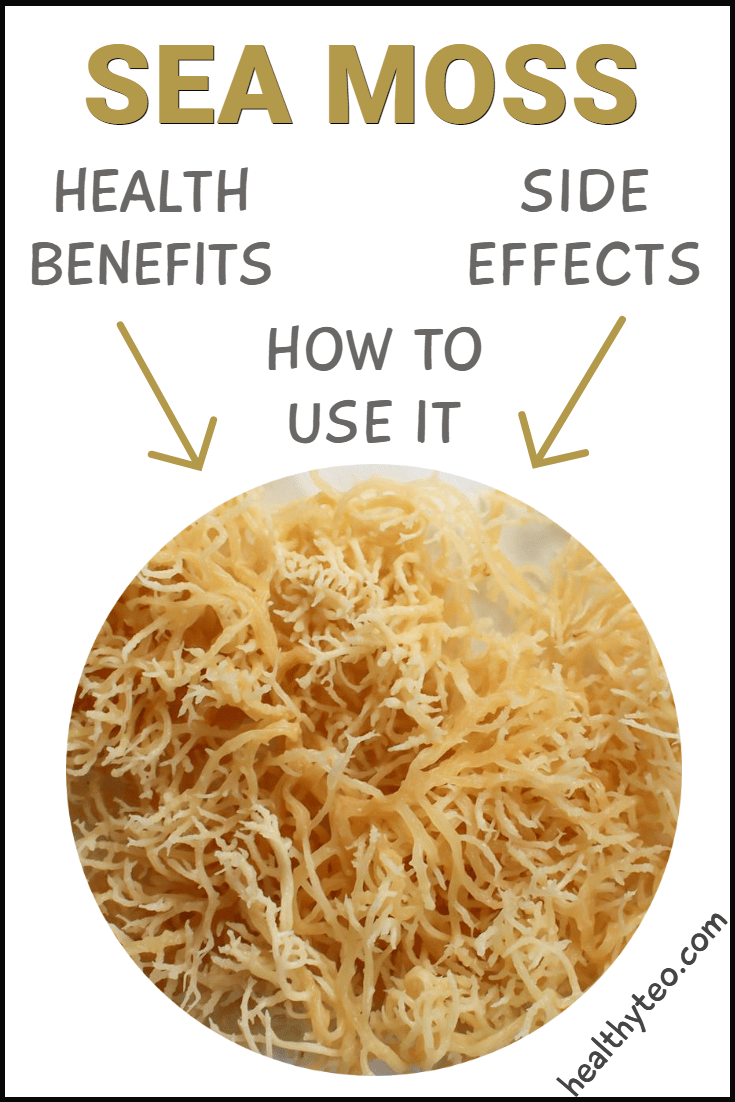Top benefits and potential side effects of consuming sea moss for your health and skin
Even it is called Sea Moss it is actually a sea vegetable or better to say algae. You can find it by the name Irish Moss or carrageen from the Irish “carragin” for “little rock”.
It is a superfood that we are sure you are going to add to your diet after reading what this sea vegetable can do for your health and wellness.
This post may contain affiliate links, which means we may receive a small commission, at no cost to you, if you make a purchase through a link. For more information, please see our disclosure.
What is Sea Moss?
Sea Moss or Irish Moss is a type of red algae that grows on the Atlantic coastlines of North America, Europe, and the Caribbean Islands.
In nature, it generally shows off a deep purple or brown color, but when it is air-dried it usually turns yellow or green.
The Irish have been harvesting to use as a medicine, and Jamaicans used sea moss traditionally to treat illness.
Irish moss is not eaten as such but used for its thickening powers when boiled in water, a result of its carrageenan content.
In the Caribbean people serve Irish moss boiled like a tea and mixed with sweetened milk, cold. Many people consume Irish moss today in pills or powdered form.

The Latin name for this algae is “Chondrus crispus” and another name is Carrageen Moss. Carrageenan is a derivative from sea moss used as a thickening agent in ice cream, yogurt, cottage cheese, and other processed foods.
By the National Agency for Research on Cancer, this ingredient was labeled as “a possible human carcinogen“. But carrageenan ( a chemically processed ingredient) is different than sea moss.
Sea moss is a whole food that is chockfull of beneficial vitamins, nutrients, and antioxidants. Some scientists say that sea moss contains 92 of the 102 minerals that the human body requires to function.
If you haven’t tried it yet we recommend you try this natural organic Sea Moss rich in vitamins and nutrients.
After reading below how sea moss is beneficial for your health and it’s multiple-uses as a food, you will ask yourself “why no one told me about this superfood?”
Purple Sea Moss
Purple sea moss scientifically known as Gracilaria is a species of red algae and it is one of the most nutrient and mineral-rich food. It is interesting to note that all purple sea moss comes out of the sea purple, which is not the case with gold sea moss.
Our article is about the benefits of sea moss (golden), but we can mention here why purple sea moss is good for you.
Benefits of Purple Sea Moss
- Rich in essential nutrients
- Supports natural immunity
- Maintenance bone strength
- Nutrition for glowing skin
- Supports a healthy gut
Health Benefits of Sea Moss
When applied topically
Joshua Zeichner MD director of cosmetic and clinical research in the department of dermatology at Mount Sinai Hospital in New York City says: “It’s rich in sulfur, which is known to lower levels of microorganisms on the skin and soothe inflammation.”
Citrulline-arginine is a component of marine biomass originating from the red algae, Chondrus Crispus. It is a dipeptide that improves the availability of arginine by increasing skin energy levels, encouraging cell growth and metabolism.
It releases arginine and citrulline (amino acids ) that are important sources of nitrogen, and crucial for protein and collagen synthesis.
Citrulline-arginine is indicated for the prevention and improvement of skin aging. It is a skin protector in extreme conditions like cold and dry climates, pollution, and air conditioning. The recommended dose is 100-1000 mg per day.
When sea moss is transformed into sea moss gel it becomes a natural gelatin-like substance rich with vitamins and minerals that can help in treating burns, dermatitis, eczema, and psoriasis. It is best to use it topically so your skin can absorb the vitamins and minerals.
When ingested
The best way to use sea moss is to add to your morning smoothies because sea moss can soothe the respiratory and digestive tract, says Robin Foroutan R.D.N., spokesperson for the Academy of Nutrition and Dietetics.
This might be due in part to the fact that like aloe and okra Irish moss is a mucilaginous food, which mucus-like texture (sticky, thick) can double as a remedy for irritation. This snotty-substance also dissolves in water, so sea moss can tend to act like a soluble fiber.
Remember: soluble fibers dissolve in water and become a soft gel that keeps you full and helps stool move through the GI tract.
Sea moss supports digestion too because it is a good prebiotic. This means it is a type of dietary fiber that is essential fertilizer for probiotics.
According to the FDA, sea moss is low in calories- 49 per 100g and loaded with key minerals like folate and iodine.
Folate is important for prenatal health and development and iodine helps the thyroid to run properly and make thyroid hormones.
Healthy thyroid function is crucial for mood improvement, digestion, and more. T3 (Tri-iodothyronine) is a thyroid hormone that eventually breaks down into DIT (DI-iodothyronine) which occurs in brown sea moss in abundance.
T4 (thyroxin) and T3 are the primary iodine compounds in a few seaweeds, including sea moss too. This is the reason why the Irish moss treats thyroid disorders effectively.
Due to high levels of nutrients like iron, magnesium, phosphorus, and zink sea moss supports the immune system and helps you to fight cold and flu symptoms.
Better Heart Health
As we mentioned above, sea moss is a great source of vitamins, minerals, and fatty acids. Food that is packed with all these components is very beneficial for your health.
- Folic Acid
- Potassium
- Vitamin D
- Magnesium
- Omega-3 Fatty Acids
These are just a small group of components of sea moss that help to reduce the risks associated with heart disease. With a consistent supply of these, you could notice positive effects like:
- Reducing the build-up of bad cholesterol
- Increasing oxygen saturation in the blood
- Building stronger blood vessels and slowing their deterioration
- Boosting of blood flow and improved circulation, which helps to control and regulate blood pressure
- Prevent organ oxidization due to strong antioxidant properties
Mood Enhancement
Because of its high mineral content, especially potassium, sea moss helps our body to maintain healthy mental and emotional health. A lack of it can lead to anxiety, irritability, and depression. Because potassium can’t be stored, we need an adequate supply of our food.
Irish moss packs more potassium than two bananas. This makes it the premier food to help boost mental health and uplift mood. Irish moss can also help with stress relief and support the nervous system because it is rich in B vitamins.
Boost Energy Levels
Sea moss contains a decent amount of folate (B9) and riboflavin (B2). Folate is needed to form DNA and other genetic material, riboflavin is important to break down proteins, fats, and carbs. When folate pairs up with B12, it also helps to create red blood cells.
Because sea moss is made of collagen proteins that strengthen and repair the connective tissues, it is a great choice for post-workout recovery food.
It doesn’t matter if you are a professional or just a beginner at fitness or any other sport, Irish moss provides many benefits. From post-workout recovery to replacing lost minerals. If you experience muscle or joint pain it will also provide relief and lubricate the joints.
What Are The Side Effects of Sea Moss?
Before incorporating it into your diet you should know that there are some side effects of consuming too much sea moss.
Too much iodine can cause thyroid disorders
One of the main potential side effects of sea moss is that can put consumers at risk of overconsumption of iodine. Consuming too much iodine can lead to an underactive thyroid (hypothyroidism).
The iodine content of sea moss and other seaweeds is highly variable because the nutritional value of sea moss can differ based on where it’s from, so can the amount of iodine in each serving. So, it is recommended to pay attention to nutrition labels if you are eating sea moss and worried about iodine consumption.
Eating 4 grams of dehydrated sea moss will provide 32 micrograms of iodine which is equal to 22% of your RDA. The recommended daily limit for iodine intake is 150 micrograms for most adults.
To put this into context the milk and other dairy products provide about 30-60 micrograms, and eggs 50 micrograms per 100 grams of the food.
So, when it comes to side effects of sea moss related to its iodine content, if you eat sea moss in moderate amounts you shouldn’t be worried. Moderation is the key and always pay attention to the label and the iodine amount. When consumed in normal amounts sea moss is safe and also beneficial for your health.
Risk of heavy metal consumption
As seaweed is known to absorb and store heavy metals, sea moss may also come with a risk of heavy metal consumption. But according to a study published in 2017 the risk of toxicity appears to be very low.
In this study were examined the levels of 20 heavy metals in 8 types of seaweed from the waters of Asia and Europe. The results showed that the amounts of heavy metals did not pose serious health risks.
Consuming sea moss in moderation will not cause any side effects and current research has not found that sea moss contains toxic levels.
Sea moss as a mask or cream
If you plan to use sea moss as a mask or cream it is important to watch for irritation, like redness, burning, or stinging. If you experience any of these symptoms talk to your dermatologists, or even better before start using sea moss as a mask or cream consult with your dermatologist first.
Other side effects of consuming or using sea moss
- Nausea and/or vomiting
- Burning or reddening skin
- Itchy or irritated skin
Like any food or food supplement, excessive consumption may be bad for your health. The same is here with the side effects of sea moss. Moderation is the key.
When consumed in normal amounts sea moss is safe, but if you experience any of these side effects that we mentioned above inform your doctor and stop consuming sea moss.
How To Use Sea Moss
Due to the many health benefits of sea moss and little side effects, it is important to use sea moss properly.
You can use sea moss daily, but to see some benefits when you use it for the skin it should pass a couple of weeks. The active ingredient needs contact time with the skin for your body to absorb the nutrients and gain the benefits.
Sea moss doesn’t have much of a taste, so you can use it as a gel (made by boiling with water) in many food items, including as a thickener in soups, smoothies, or desserts like mousse.
Sea moss gummies are ideal for keto and alkaline diet support. A combination of sea moss, bladderwrack, and burdock root makes these gummies a superfood, which contains 92 natural minerals out of 102 our bodies need to maintain homeostasis.
Some people also add powdered sea moss directly to smoothies—just follow the serving size on the product label.
Try using it in:
- Smoothies
- Dairy-free elixirs
- Blended soups
- One-pot meals and stews
- Salad dressings
- Homemade nut/seed milk
- Nut cheeses
- Raw desserts
- Chocolate
How much sea moss should I take daily?
Since sea moss is rich in iodine you need to be cautious when it comes to overeating it. The recommended quantity or dosage of sea moss is 1 to 2 tablespoons or 4 to 8 grams of sea moss per day.
How To Make Sea Moss Gel
Below is a simple and effective way to prepare Irish moss in less than 15 minutes!
After refrigeration, the final product is a delicious sea moss gel that can be added to a variety of recipes. (Recipe from jamaicaherbal.com)
1. Wash thoroughly with water to remove salt or other impediments (Sea Moss grows wild in the ocean).
2. Blend 6 oz of the sea moss with 32 oz of hot water for a few minutes (initially blend at low speed to prevent splashing as the blender cuts through the moss).
3. Add two cinnamon sticks, a teaspoon of ginger root, and blend for a few more minutes until smooth.
4. The gel can be stored for up to 10 days in the refrigerator. It can also be added to smoothies or other recipes as a thickening agent.
If you don’t want to lose time preparing it at home, here is a great choice for you.
Irish Moss Smoothie Recipe
- 3-4 oz of Sea Moss Gel
- 12 oz of almond milk
- 1 banana
- 1 cup of ice
- 4 tablespoons of honey
- 1 teaspoon of vanilla
Blend for 2 minutes, or till creamy
How To Make Sea Moss Lotion at Home
Recipe by Janice Cox
This is a perfects lotion that you can use after a long day in the sun.
Ingredients:
- 1 tablespoon powdered Irish moss
- 1 cup distilled water
- ¼ cup aloe vera gel
- 2 tablespoons almond oil
Preparation:
- Soak Irish moss in distilled water for 20 minutes. Pour mixture into a small saucepan and boil for 20 minutes. Strain off solids; you will have a clear jelly.
- Measure ¼ cup of the seaweed jelly, then mix it with the aloe vera gel. Let the mixture cool completely.
- Pour seaweed mixture into a blender and blend on low speed; slowly add the almond oil in a thin stream until blended. You will have a light, white lotion.
- Pour lotion into a clean container. To use, massage a small amount into your skin.

Final thoughts on Sea Moss benefits and side effects:
Because sea moss has no or little flavor you can use it in many recipes and don’t be afraid to experiment with some of your ideas.
If you haven’t decided yet to use it or not, try it. Sea moss has many health benefits and many uses. It is your choice to decide whether you will use it as a food in your daily diet or for soothing the skin and skin cell renewal.




